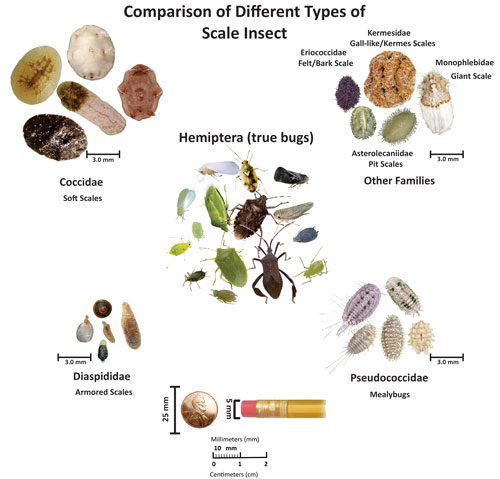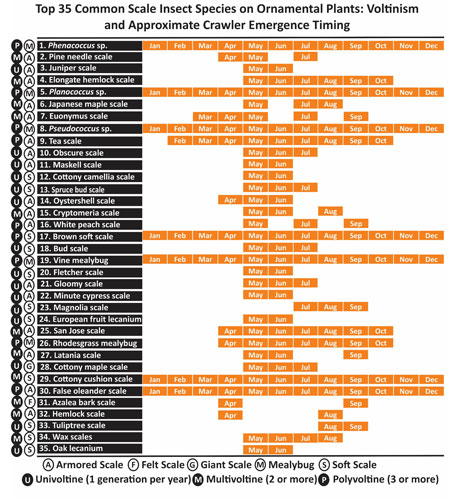7/31/2025
Target Scale Insect Crawlers to Prevent Sticky Situations
JC Chong & Zee Ahmed

We’ve been working with scale insects for a major part of our professional careers. For a couple of entomologists, we look at scale insects as simply fascinating because of the variations in taxonomy, biology and ecology. They look nothing like their cousins in the Order Hemiptera (the true bugs, Figure 1). First of all, scale insect females are wingless. Adult males are short-lived and have one pair of wings so they can fly and look for mates.
Scale insects come in different shapes and sizes. Most species are cryptic—so much so that you’ll miss them if you aren’t looking carefully enough! The ability to remain hidden in plain sight allows scale insects to avoid detection and control, which then allows them to grow into a bane of our existence.
There are about 1,100 scale insect species in North America (about 9,000 species in the world). Each species feeds on one or more plant species, and many of these plant species are what we grow. Some plant species are more susceptible to a wider range of scale insects; some are less. Damage or symptoms of infestations can also vary greatly among plant species and scale insect groups.
What scale insect are you dealing with?
Answering this question seems like a daunting task because there are 1,100 species, but it isn’t. Bill Klingeman of the University of Tennessee and a few colleagues (including JC) examined identification records in the United States from 2005 to 2017 and identified the most common scale insect species affecting ornamental plants in a review paper. By familiarizing yourself with the Top 35 species listed in Figure 2, you may be able to identify more than 85% of all scale insect samples you come across. (Training to identify 35 species has a much lower learning curve than doing the same for 1,100 species!)
You should also learn to identify some of the spreading invasive species, such as the crape myrtle bark scale, that aren’t captured by the Top 35 list. You can even come up with a tailored list of the most common species in your region by reading the review article. For species that you don’t recognize, you can send samples to your favorite diagnostic services for species confirmation.
Knowing the offending species is important to answering other questions, such as, “When do the crawlers emerge?” and “How many generations does this species have?” Crawler is simply another name for hatchling. They’re called crawlers because this is the only life stage when hatchlings actively disperse from their mothers and competing siblings to new feeding sites or hosts.
Why do you need to know when crawlers of each generation emerge? That’s because crawlers have almost no wax deposits on their bodies and are therefore vulnerable to unfavorable environmental conditions and insecticide treatments. If you’re dealing with a species that has multiple generations per year, you should be prepared to make multiple treatments, with each treatment targeting crawlers from one generation.
How do you know when crawlers emerge?
You can start by searching for life history information of the species you’re dealing with. Be warned: There’s a lot of scattered information online and in various resources, which can drive even the most patient of us into despair. We’ve provided approximate crawler emergence times (with a bias towards the southern U.S. because of where we live and work) and the numbers of generations (voltinism) of the Top 35 species in Figure 2. Notice that most soft scale species have one generation per year, whereas the voltinism (number of generations per year) of armored scales is more variable. It means that a program against armored scales may involve more applications to target multiple generations.
Also, notice that the emergence time information in Figure 2 is generalized. We suggest you refine the information for your state or the surrounding states or by talking to your local extension service or entomologists like us. In our experience, armored scales are more difficult to control not only because of the variable voltinism, but also because they’re well protected by the shells.
Another method of approximating crawler emergence time is to use degree-day models or plant phenological indicators. Again, you can find this information online or by talking to your local extension service. This review paper contains information on crawler emergence time and the voltinism of soft scales. A similar review for armored scales hasn’t been conducted.
 It doesn’t matter what method you use—calendar dates, degree-day models or plant phenological indicators—they only give you a guess of when crawlers may emerge. You still need to look for the crawlers to confirm that they’re indeed emerging before making insecticide application. You can look for them visually by checking on infested trees or shrubs about a couple of weeks or so before the approximated emergence times.
It doesn’t matter what method you use—calendar dates, degree-day models or plant phenological indicators—they only give you a guess of when crawlers may emerge. You still need to look for the crawlers to confirm that they’re indeed emerging before making insecticide application. You can look for them visually by checking on infested trees or shrubs about a couple of weeks or so before the approximated emergence times.
Our favorite monitoring method is to build a sticky band by wrapping electrical tape (sticky side out) around the branches of a few infested trees. You can set up the sticky bands a couple of weeks before approximated dates and check for crawlers trapped on the bands once a week. Start insecticide application as soon as or within a couple of weeks after crawlers are found.
When scouting, pay attention to stock plants and plants that are holdovers from the previous season because they’re more likely to suffer from scale insect infestations, which have time to build up to a damaging and noticeable level. Also pay attention to liners, which is a major pathway of introducing scale insects into nurseries. Monitor these plants closely and manage the infestation soon after it’s found.
Insecticides—Which one should you choose?
We often recommend neonicotinoids. True, neonicotinoids have a tarnished reputation, but they’re the most effective and versatile options for scale insect management. They can be sprayed (on foliage and basal trunk), drenched, injected or top-dressed as granules. Their systemicity is particularly valuable in treating tall trees. Other systemic insecticides can also be used, but they typically take longer to translocate to the canopy where they kill the feeding scale insects. Typically, one drench or injection treatment before crawler emergence is needed per year.
It’s important to know that no insecticide, including systemic insecticides, works particularly well against adults. Also, systemic insecticides don’t perform well when used against scale insect species that are feeding on woody tissue, such as trunks and branches. Systemic insecticides aren’t particularly effective against armored scales because this group feeds on cell contents instead of on phloem like soft scales. You’ll have to include spray treatment to control armored scales species and species that feed on woody tissue.
Insecticides that work well are insecticidal soap, horticultural oil, insect growth regulators (IGR; particularly buprofezin or pyriproxyfen), and a tank mix of horticultural oil and IGR. Other insecticides can also be used, but those listed here have lower impacts on predators and parasitoids. Again, targeting crawlers is more effective than targeting other life stages. We suggest making two applications (two weeks apart) against each generation of crawlers.
There are few biological control options for scale insect management in nurseries. However, biological control is important for suppressing scale insect populations in landscapes. Many predators, parasitoids and diseases can be found munching away at scale insects. The worst thing you can do is mess up the activities of these natural enemies by using broad-spectrum insecticides. Another effective strategy for conserving natural enemies is to time insecticide applications to avoid times of high natural enemy activities. GT
This article is modified from a previously published PestTalks newsletter.
JC Chong is a Technical Development Manager at SePRO Corporation and editor-at-large of the PestTalks newsletter. Muhammad Z. “Zee” Ahmed is an Assistant Professor and Extension Specialist of turf and ornamental entomology at Clemson University.